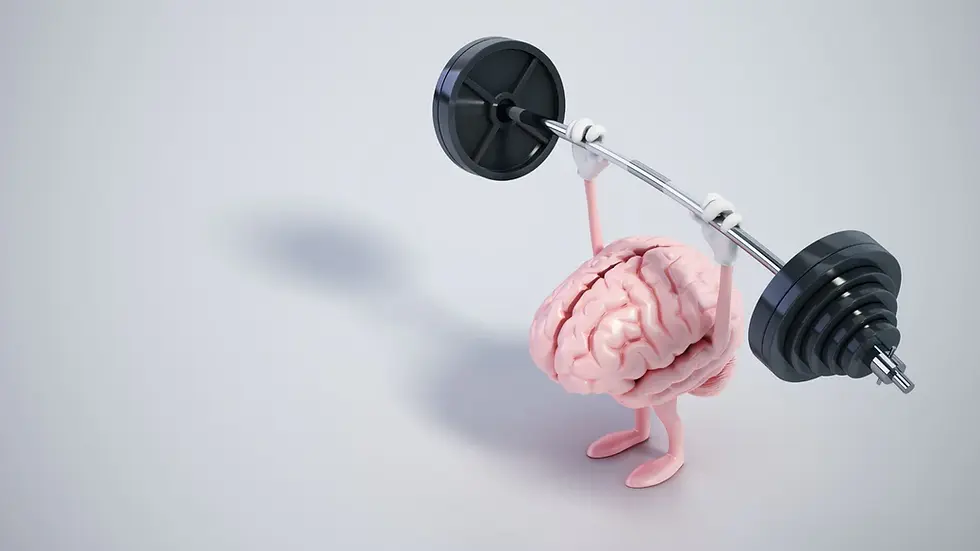The Default Mode Network (DMN) and training its abilities in the brain
- Rachel Langford

- Jul 15, 2021
- 4 min read
While most research studies focus was put on which brain areas are becoming MORE active when we are performing a cognitive task or trying to focus, there are some areas that become LESS active during task and it is not less important that they do! The brain need to learn when to activate and deactivate the relevant areas so our cognitive processing will be the most efficient.
The Default Mode Network (DMN) is one of them. The DMN is very active when we are doing "nothing" or resting, and it DECREASE its activity when we are on a cognitive task such as visual search, spatial attention, language and the practice of language, memory and imagery tasks.
In some brains, such as brains of people with ADD and ADHD, the brain does not know how to efficiently adjust the activity in the DMN based on the cognitive requirements of that point in time.
The concept of a default mode network was developed after researchers inadvertently noticed surprising levels of brain activity in experimental participants who were supposed to be "at rest"--in other words they were not engaged in a specific mental task, but just resting quietly (often with their eyes closed).
Scientific publication about the function of the DMN network, which we train in many brains in clinic, are focusing on different fields of functions that this network is involved with. It comes up in brain activity assessment as a component found out of balance in different psychiatric disorders, in ADHD and other cognitive disorders (as a task driven network), in functional connectivity processes, self referential processing and mind wondering (for example in ADD and AS cases), and even in relation to neurophysiology and cell biology.

The brain areas that are involved in the function of the DMN are:
• Dorsal mPFC: responsible of the evaluation of your actions and plans
• Ventral mPFC: involved in reward and stimulus association
• Nucleus accumbense: involved in reward signals
• Hippocamus: involved in episodic memory
• The parietal lobes:
o Right parietal: me in the physical space
o Left parietal: knowledge space – including language processing aspects of it, for example, how the concept of the word “oranges” fits in the semantic space of “fruit”.
• Retrosplenial cortex: strongly connected to the hippocampus and has been shown to be involved with producing our own map of the world. The physical space around us but also the experiences we go through and how we navigate through them in time.
Genetics and cell connectivity in the DMN
Richiardy 2015 was studying whether the fact that all the areas of the DMN are always working together means that genetically there are similar to each other more that to other parts of the brain. They found that this is indeed the case. They share more common gene expressions between themselves compared to other parts of the brain.
Whitesell 2020 showed that cells in the areas of the DMN are more connected to each other than to other parts of the brain.
Interestingly, in terms of cognitive decline, it has been shown by brain imagining that both the brain metabolism, as well as cell atrophy in the brain of patients suffering from Alzheimer disease, are in the areas that are part of the default mode network. Indeed, one of the common symptoms of sever Alzheimer’s is that the person loses the sense of the self in the space. They cannot remember their way home for example (Buckner et al, 2005). And as we motioned above, the parietal lobe areas that are part of the DMN are responsible for understanding and processing cognitive space and physical space.
The DMN and addiction
Studies have suggested that DMN activation is positively correlated with drug craving/withdrawal, while substance consumption suppresses activity of DMN (Cole et al., 2010; Sutherland et al., 2012).
Failure in suppressing the DMN activity can increase the error rates in cognitive tasks (especially tasks involving inhibitory control) and can interfere with goal-directed behaviours (Eichele et al., 2008). This can lead to higher vulnerability of substance users to relapse in the presence of substance-related cues.
Background
Its discovery was an unexpected consequence of brain-imaging studies first performed with positron emission tomography in which various novel, attention-demanding, and non-self-referential tasks were compared with quiet repose either with eyes closed or with simple visual fixation. The default mode network consistently decreases its activity when compared with activity during these relaxed non task states. The discovery of the default mode network reignited a longstanding interest in the significance of the brain's ongoing or intrinsic activity. Presently, studies of the brain's intrinsic activity, popularly referred to as resting-state studies, have come to play a major role in studies of the human brain in health and disease. The brain's default mode network plays a central role in this work.
(Marcus E. Raichle, Annual Review of Neuroscience Vol. 38:433-447 (Volume publication date July 2015)
* Some of the materials mentioned in this article were summarised from a talk by Dr. Anish Mitra at the Stanford Psychedelic Science Group









Comments